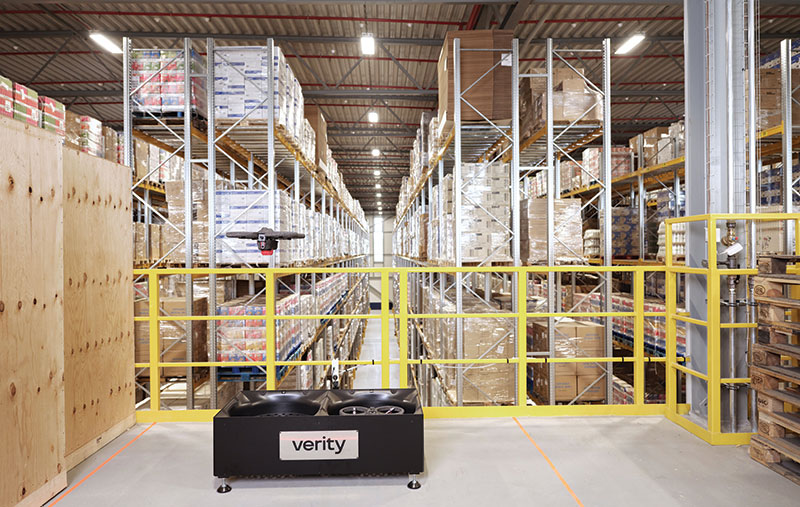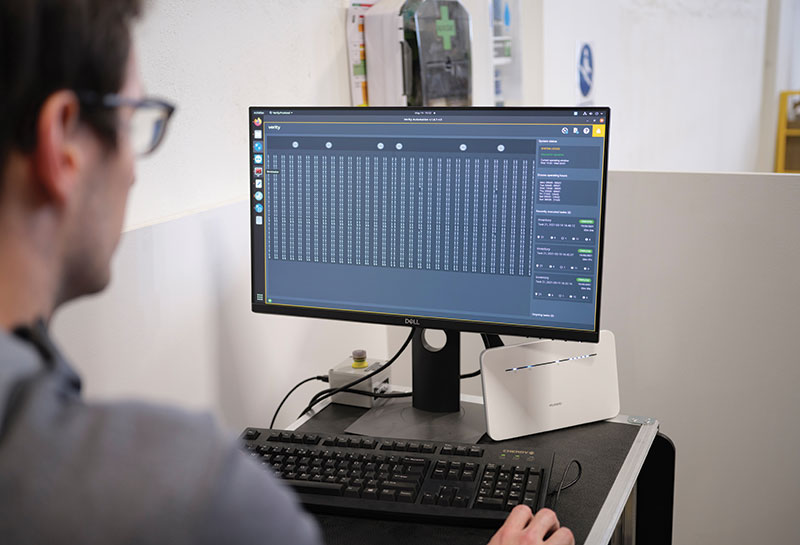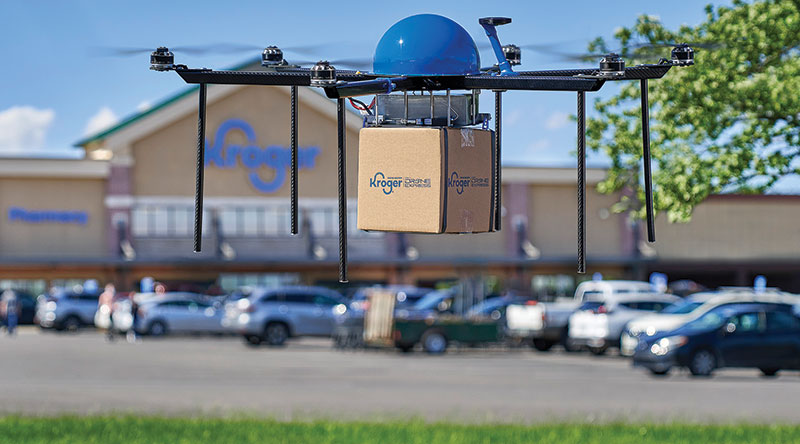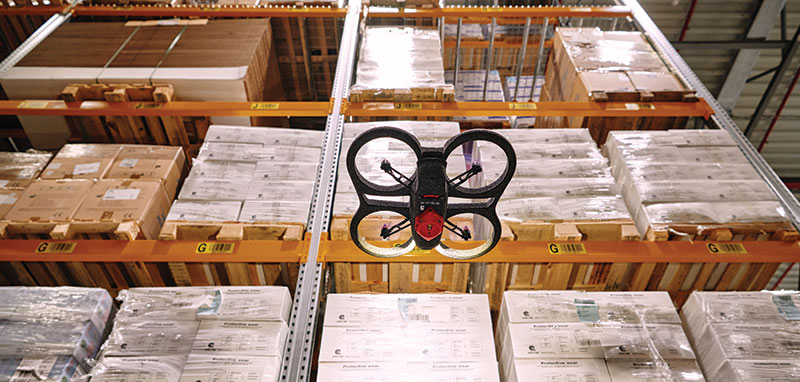Are Distribution Centers (DCs) Ready for Drones?
Despite the hype, drones have been slow to catch on in the supply chain. But some intriguing new use cases suggest the technology could be ready to break out inside the DC.
It’s the weekend at a distribution center in Hedehusene, Denmark, operated by DSV, a global third-party logistics (3PL) provider.
At 9 p.m. each night the previous week, the facility’s warehouse management system (WMS) uploaded a file to a drone operating system from Verity, a Swiss-based provider of autonomous indoor drone systems. The files detail the pallet moves made by lift truck operators that day. They also tell Verity’s software which pallet locations need to be inspected based on information that was scanned into the system by the operators as they put pallets away into storage, retrieved them or moved them from one location to another.
Now that the warehouse is closed for the weekend, a fleet of 12 drones takes flight for a visual inspection of the pallet locations identified by the WMS. Using camera-based imagery, the drones look for the pallet license plate bar code tag that should be at the selected locations. If a space is empty, or if there is no tag or the wrong tag, the drone sends a photograph of the location back to Verity’s system.
In turn, the system creates an exception report that’s ready for DSV’s team when it returns on Monday. The team can then conduct an in-person inspection to address the issue. Meanwhile, the WMS inventory has been updated with accurate information requiring minimal human intervention. Better yet, the drones don’t need a drone pilot—Verity’s drone operating system directs the operations.
The drones in the Danish facility went live in May of this year, one of two DSV facilities to use the technology, with more to come. The expected benefits? DSV expects to reduce the costs associated with cycle counting; reduce or eliminate disruptions and wasted time spent searching for misplaced pallets; and improve the overall quality of its operations, according to Luca Graf, senior director of innovation at DSV Global Transport and Logistics.
Graf and his team led the project. What’s more, the local operations managers are in discussions with Verity on ways to expand the capabilities of the drones into other processes.
For now, expansion is in the future. However, the cycle counting process at DSV, and a similar operation at three IKEA facilities, begs the question: Are drones finally ready to fly in the warehouse and distribution center?

Fits and starts
It’s been nearly eight years since the Dec. 1, 2013, episode of “60 Minutes,” where Jeff Bezos teased the logistics world with the introduction of Amazon Prime Air, a drone program that promised to revolutionize e-commerce home delivery. A headline on “The Verge” that night said it all: “Delivery drones are coming: Jeff Bezos promises half-hour shipping with Amazon Prime Air.” The author of that story described the process whereby drones would be able to deliver packages up to 5 pounds to your house in less than half an hour. “A drone sits at the end of a conveyor belt, waiting to pick up a package — Bezos says 86% of Amazon’s packages are under 5 pounds — and can carry them up to 10 miles from the fulfillment center. As soon as Amazon can work out the regulations and figure out how to prevent your packages from being dropped on your head from above, Bezos promised, there will be a fleet of shipping drones taking the sky.” Like that old E.F. Hutton commercial, when Bezos speaks, people listen. The “60 Minutes” segment set off a drone investment frenzy where just about any 15-year-old putting together a drone kit in his bedroom could get startup funding to do direct-to-consumer delivery. Fast forward to 2021, and most of us are still waiting for Amazon to work out the regulations with the FAA and figure out how to prevent packages being dropped on your head. That isn’t to say there hasn’t been progress on deploying drones in the supply chain, but the applications have been few and far between. Alphabet’s Wing drone delivery program has been piloting drone deliveries since 2019, but is limited to a single town in Virginia. UPS partnered with CVS to deliver prescriptions by drone to the Villages retirement village in Florida. And drones have been used to deliver essential supplies, such as medical supplies, to remote communities in countries without an infrastructure. Coldchain Technology Services, a healthcare supply chain management company, is in talks with drone delivery provider Draganfly to ship medical supplies, including Covid vaccines, on an experimental basis. More recently, Kroger announced a partnership with Drone Express to provide grocery delivery by drone (see box). Still, as the team at Verity points out, the evolution of commercial drone applications, especially outdoors, has been notably slow, “especially in the tech landscape where innovation usually occurs at lightning speed,” says Markus Waibel, Verity’s co-founder and COO. Verity hopes to change that. The company cut its teeth in indoor entertainment venues “where failure is not an option,” in Waibel’s words: Creating light shows for Cirque du Soleil, Metallica and Celine Dion, to name a few. In 2016, the company entered the industrial space, developing drones that could be used in warehouses, distribution centers and factories.

A key to making drones viable was the development of a software-controlled system rather than one in which the drones were directed by a drone pilot. After all, it’s difficult to build a business case when you’re replacing a lift truck operator who performs multiple tasks with a much higher paid drone pilot who has perhaps just one task. With deployments like the ones at IKEA and DSV, indoor drones are moving closer to reality.
Investigating drones
So, what does it take to make that a reality? That was a question for Luca Graf, DSV’s innovation director; Tim Haupter Madsen, manager and head of warehouse operations at DSV’s Danish solutions warehouse in Hedeland; and Kenneth Jessen, the site engineer who works with issues related to the WMS system such as inventory. Graf says his curiosity was piqued in large part from his background in the commercial airline industry, where he worked on the digital transformation of the passenger side of the business before joining Panalpina, now known as DSV, about four years ago. “I’m fascinated by flying objects,” Graf jokes. “That got me thinking about how drones might be able to improve our business.” An early idea was an outdoor initiative using drones to fly packages back and forth across a busy street to link two Canadian warehouses. That project is still active for one specific customer. Graf says that DSV does workshops with its customers to identify pain points and then see what emerging technologies might address the issues. One example: Digitizing bills of lading using Blockchain, a solution that proved not to be scalable at the time. Graf’s team believed they had found a use case using drones for cycle counting. “A drone, after all, is equipped with cameras and sensors to collect data,” Graf says. “We immediately thought about inventory control processes, like cycle counting or taking a wall-to-wall inventory.” One of the pluses to an indoor application was that there were fewer government regulations than those associated with an outdoor operation. Regulatory approval is still a sticking point for direct-to-consumer delivery.
Taking drones to the last mile with Kroger
Perhaps the hottest topic in grocery e-commerce these days is micro-fulfillment, or the utilization of materials handling automation to fill online orders. Then, what? How are you going to get those orders to the customers who ordered them?
One idea, announced by Kroger in May, is a pilot program with Drone Express, a division of Telegrid Technologies, for the drone delivery of orders weighing 5 pounds or less within a 2-mile radius of the store. Kroger is launching the pilot from a store in Centerville, Ohio.
Now, 5 pounds may not sound like a lot, but it’s enough to deliver a rotisserie chicken dinner with the fixings, notes Beth Flippo, Telegrid’s chief technology officer, a woman-owned business. Among the products Kroger is going to start with are a baby care bundle with wipes and formula, a child wellness bundle with over-the-counter medications and fluids, and a S’mores bundle with graham crackers, marshmallows and chocolate. The aim is for a customer to place an order that will be delivered in 15 minutes.
So, how does it work? According to Flippo, Drone Express will operate from an on-site drone hangar, essentially a trailer in the Kroger parking lot. The drones will be managed by licensed Drone Express pilots.

Orders are securely bubble wrapped and packaged in a cardboard box, and then dropped by the drone to the location of the customer’s choice. Yes, dropped: The drone does not land. “Because we only do one delivery at a time, we can break the anchor to your home,” she says. “If you’re at work and order Tylenol, it goes to work. If you’re in a park watching your kids’ sports game, we can deliver your Gatorade to the field.”
Flippo says they have done successful tests dropping eggs. Flippo’s drones can carry more than 5 pounds, and potentially travel more than 2 miles. However, 95% of Kroger’s customers live within 2 miles of a store, and what they’re really trying to demonstrate “is to show the FAA that we can safely deliver in an urban setting into everyday life.”
For now, the company plans to operate three drones per Kroger location, with one pilot per drone. Each drone can make four deliveries an hour. Eventually, one pilot will manage three drones and 12 deliveries per hour.
Flippo says her company can make a delivery for $8, which she believes is cheaper than anyone else on the market. The inevitable last-mile delivery question of who pays the delivery charge—Kroger or the customer—is still to be determined.
From Flippo’s perspective, what’s most exciting about the possibility of drone delivery is that it gives local brick-and-mortar retailers an opportunity to compete with the online behemoths. “I really think autonomous vehicles on the ground and in the air will lead to people ordering locally again and save that retail way of life,” she says.
The question was whether there was a mature technology allowing for fully autonomous operation. If the drones required a pilot to fly them, there would be no business case. In 2019, DSV began reaching out to startups in the drone space. In October of that year, the 3PL performed tests with two vendors. “We concluded that the technologies we were testing were not robust enough because they required a drone pilot,” Graf recalls. In January 2020, Graf learned about Verity, a drone provider in Switzerland, through a mutual contact. At the time, he says, Verity’s industrial drones were still in stealth mode. However, the technology company was in discussions with Prologis about doing tests in the warehouse operator’s innovation lab in San Francisco. Prologis is also a DSV partner.

Graf spoke to his counterparts at Prologis, and the two companies agreed to partner on a test in the San Francisco lab. “We ran a test for a week, the drones worked, and they didn’t need a drone pilot,” Graf recalls. “That was our proof of concept.” In August 2020, DSV installed a drone fleet in a facility in the Netherlands for a month-long pilot. Over that month, the drones flew 2,800 flights and scanned 20,000 pallet locations. “We realized we could scan 99.5% of all labels, which allowed us to prove the business case,” Graf says. Following the project pilot, the innovation group presented the business case to the warehouse organization. The facility in Denmark was the first to sign on to the technology.
Going live
Madsen, the site manager in Denmark, says that like many 3PLs, DSV has traditionally relied on conventional materials handling processes to operate its facilities. But, in recent years, as many 3PLs have also discovered, that approach is less sustainable than it was in the past. For one, labor in Europe is difficult to source and expensive, much like here in the United States. “We need to bring our labor costs down, and that’s difficult to do without automation,” Madsen says. Drones are that facility’s first venture into automation.
Instead of fast-moving consumer goods, the Danish facility focuses on higher-value goods like furniture. Many loads are palletized. Given the value of a pallet-load of material, keeping an accurate inventory is critical. Among the issues being experienced were that operators put pallets away into storage, then forgot to scan the pallet location, or operators picked the wrong pallets.
“The next day, we’d have to search through the whole warehouse because a driver might forget where they stored a pallet needed for an order,” says Jessen, the site engineer. “We’d have a fair number of people manually checking on locations to update the inventory.”
A further complication was a move from a smaller facility into the newer, much larger Hedeland DC. “The potential for error is higher and the ability to find a missing pallet is harder in a large space,” says Madsen. Prior to drones, they did investigate the use of automatic guided vehicles (AGVs) for pallet movement and storage since an AGV won’t put a pallet in a wrong space, but after looking at a proposal Madsen determined the technology was “too futuristic” for that facility.
Then, along came drones, and a visit to another site where they were working, and doing so with very light integration with the WMS. “What sold us is that it was almost plug and play,” Madsen says. “The install was going to be very fast, and the business case seemed strong.”
The drones are up, running and doing what they were designed to do. Madsen adds that they are building a new warehouse and looking into using drones there. The technology is also going into a facility in the Netherlands.
According to Madsen and Jessen, the drones have been accepted by associates in the facility. “They’re just happy they don’t have to do cycle counting or hunt for missing pallets,” Madsen says.
While it’s still early, they have ideas for expanding the use case in the future, technology permitting. One idea is to eliminate having an operator scan a pallet license plate bar code label and a location bar code label to marry the pallet to a storage location.
Instead, the operator will put a pallet away and the drone can scan the aisle later to update the WMS. Another potential use case is for the drones to count the number of cartons on a pallet.
“For now, we’re detecting empty locations and full pallets,” Graf says. “In the future, we may be able to scan broken pallets to estimate the number of cases remaining on a pallet, do humidity testing and even quality control and safety by analyzing whether the pallet has been loaded correctly.”

Article Topics
Inventory & Picking News & Resources
Manhattan Associates selects TeamViewer as partner for warehouse vision picking Consultant and industry leader John M. Hill passes on at age 86 Siemens, Universal Robots, and Zivid partner to unveil smart robotic picking solution AI-based inventory monitoring solution provider Gather AI raises $17 million NRF 2024 retail sales forecast calls for growth Swisslog gives live demonstration of ItemPiQ latest evolution Cimcorp automates fresh food distribution with flexible storage, order picking solutions More Inventory & PickingLatest in Materials Handling
Beckhoff USA opens new office in Austin, Texas Manhattan Associates selects TeamViewer as partner for warehouse vision picking ASME Foundation wins grant for technical workforce development The (Not So) Secret Weapons: How Key Cabinets and Asset Management Lockers Are Changing Supply Chain Operations MODEX C-Suite Interview with Harold Vanasse: The perfect blend of automation and sustainability Consultant and industry leader John M. Hill passes on at age 86 Registration open for Pack Expo International 2024 More Materials HandlingAbout the Author
Subscribe to Materials Handling Magazine

Find out what the world's most innovative companies are doing to improve productivity in their plants and distribution centers.
Start your FREE subscription today.
April 2024 Modern Materials Handling

Latest Resources












